Whether they admit it or not, everyone wants to feel strong. But not everyone has the time, desire, or ability to spend countless hours lifting weights in the gym. The good news is there are other ways to quickly and effectively build your strength, with stability exercises being one such approach. We chatted with Nadia Murdock, CPT, a certified fitness instructor at Garage Gym Reviews, who shares her top 10 stability exercises to build strength that you can seamlessly work into your workout routine.
No matter where you are on your fitness journey, mastering these stability exercises can take your strength training to the next level. Stability exercises pack a ton of potential health benefits beyond boosting your strength. According to a 2022 study in Frontiers in Physiology, core stability exercises can enhance athletic performance and improve balance, coordination, and functional fitness (your ability to perform everyday tasks).
“Focusing on exercises that improve your stability is key for many reasons, including improving balance, injury prevention, building core strength, boosting athletic performance, and improving posture,” explains Murdock. “Remember to use these exercises as a guide and start with the ones you feel most comfortable with. Gradually increase your intensity while keeping proper form and technique to prevent injury.”
Read on for the 10 best stability exercises to build strength, according to Murdock. And when you’re done, don’t miss these 10 Bad Habits That Cause You To Lose Muscle Mass.
Single-Leg Balance
If you want to take your balance to the next level, research shows this stability exercise is a must. Plus, it can strengthen muscles in your legs, core, and ankles.
To perform it, Murdock says, “Stand on one leg, and hold the position for 30 to 60 seconds. Switch legs, and repeat. As you progress, you can increase the difficulty by closing your eyes or standing on an unstable surface like a foam pad.” Repeat this three to four times daily.
Planks
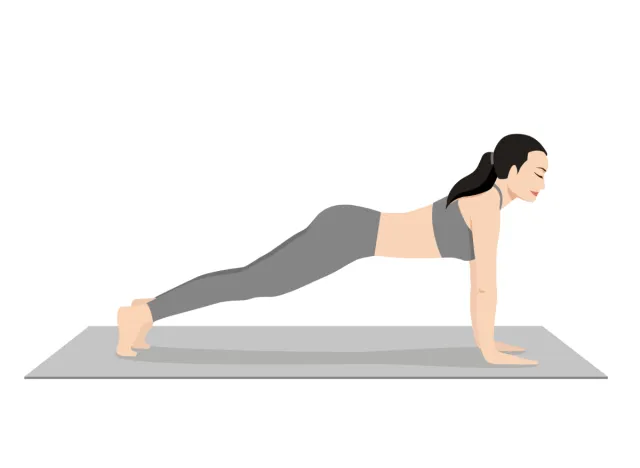
The classic plank is more than a core-strengthening movement; it’s a full-body exercise that targets your core, shoulders, and back.
“This signature move can be performed anywhere,” states Murdock. “You can hold it on your hands or forearms while keeping your body straight from head to heels. Start by holding it for 30 seconds and progress to 60 seconds over time.” Perform this exercise three to four times, resting for one minute between rounds.
Side Planks
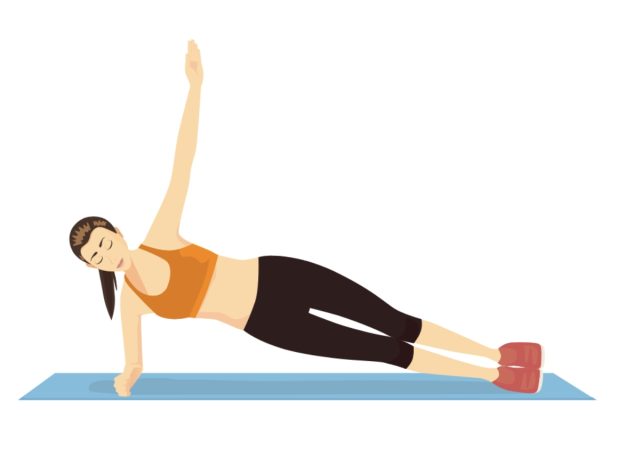
This plank variation builds core strength and stability by targeting the obliques (side abs).
To start, Murdock recommends opting for either a straight arm or forearm side plank. She says, “Lie on your side, and prop yourself up on your elbow or hand, keeping your body straight from head to heels. Hold for 30 to 60 seconds on each side.” Repeat three to four times with one minute of rest each time.
Bird Dogs
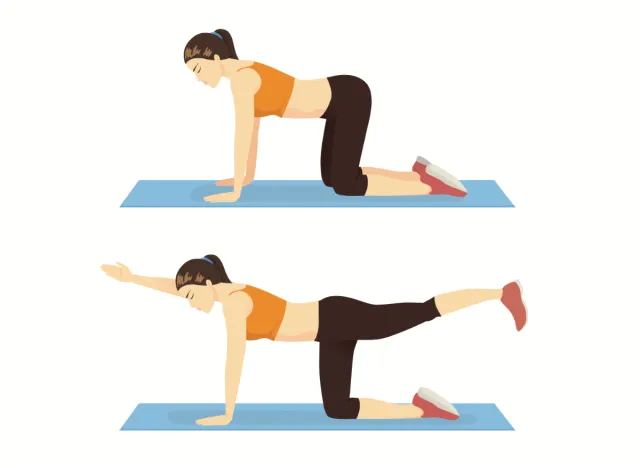
Get ready for a unique ab exercise that’s a surefire way to strengthen your core, lower back, and glutes.
“Start in a tabletop position, ensuring your knees are underneath your hips and you’re maintaining a neutral spine,” Murdock explains. “Extend one arm forward and the opposite leg back while keeping your core engaged. Hold for a few seconds, then switch sides.” Complete three to four sets of 10 to 15 reps per side. Rest for one minute between sets.
Bosu Ball Squats
Grab a Bosu ball (an exercise ball that looks cut in half), get into a squat position, and prepare to build strength in your legs, glutes, and core.
Murdock says, “Stand on a Bosu ball with the flat side down. Be sure to find the right location on the Bosu where it’s challenging, but you feel stable enough to maintain proper form. Perform squats by bending your knees and lowering your hips as if you were sitting back in a chair.” Aim for three to four sets of 10 to 15 reps with one minute of rest between sets.
Single-Leg Deadlifts
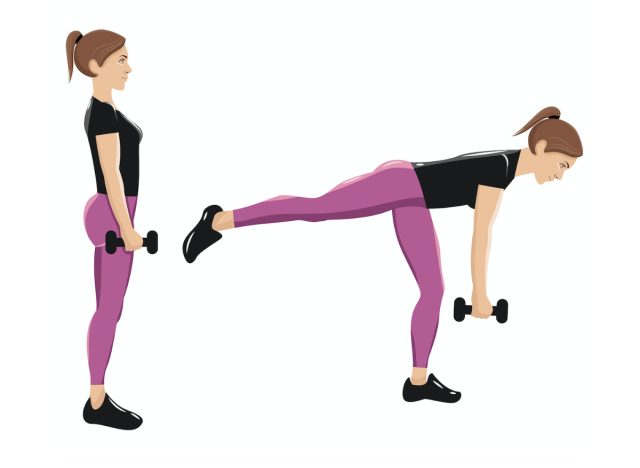
According to research, this exercise targets the hamstrings, glutes, and core while improving balance and stability.
“Stand on one leg while holding a dumbbell or kettlebell in one hand,” instructs Murdock. “Ensure the weight is challenging enough but not too heavy that you can’t perform the exercise. Hinge at your hips, and lower the weight toward the ground while lifting your back leg behind you for balance. Find a focal point on the ground without tucking your chin into your neck. Keep your back straight.” Perform three to four sets of 10 to 12 reps per leg, resting for one minute each time.
Stability Ball Knee Tucks
This movement will help build abs of steel—especially in those lower abs. Murdock suggests starting in a plank position with your feet on a stability ball. Then, use your core to pull your knee toward your chest while rolling the ball forward. Extend your legs back out to return to the starting plank position. Go for three to four sets of 10 to 15 reps, and rest for one minute between sets.
Resistance Band Rows
Using resistance band exercises is effective for building strength. This particular exercise engages muscles in the upper back and biceps.
To perform this move, Murdock tells us, “Anchor a resistance band to a sturdy object like a tree trunk, pole, or banister at chest height. Hold one end of the band in each hand, and step away to create tension. Engage your core, and pull the band toward your chest, squeezing your shoulder blades together. Slowly return to the starting position.” Complete three to four sets of 10 to 15 reps with one minute of rest between sets.
Stability Ball Roll-outs
Next up are stability ball roll-outs, an underrated yet effective exercise for developing rock-solid core strength and stability.
“Kneel in front of a stability ball with your hands on top of the ball,” says Murdock. “Roll the ball forward, extending your arms in front of you while keeping your core engaged. Roll back to the starting position.” Aim for three to four sets of 10 to 15 reps with one minute of rest.
TRX Suspension Trainer Rows
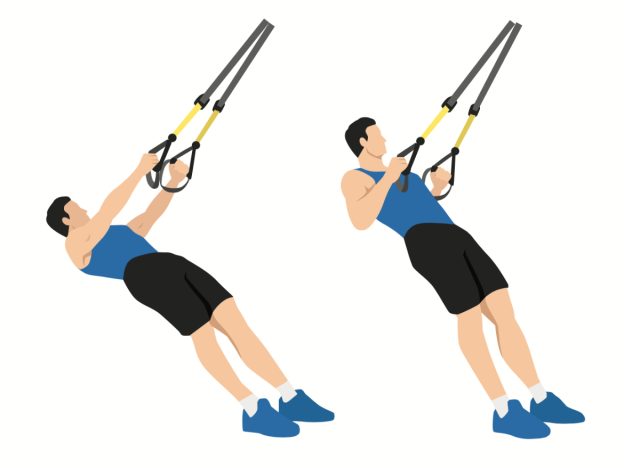
“Hold onto TRX handles with your palms facing each other and lean back, keeping your body straight,” explains Murdock. “The further out you walk your feet, the harder the exercise becomes. Engage your core, and pull your chest toward your hands, squeezing your shoulder blades together. Slowly lower yourself back to the starting position.” Perform three to four sets of 10 to 15 reps. Rest for one minute between sets.









